MXA MOTOCROSS RACE TEST: 2018 HUSQVARNA FC450

Q: FIRST AND FOREMOST, IS THE 2018 HUSQVARNA FC450 BETTER THAN THE 2017 FC450?
A: Yes, but you could upgrade your 2017 FC450 to 2018 specs for less than a grand.
Q: WHAT WOULD IT TAKE TO TURN A 2017 FC450 INTO A 2018 FC450?
A: There are only a few changes that need to be done, a few that you could do if you are anal-retentive and a few that you could ignore.
Ignore list. You can safely ignore the new graphics, radiator guards, C4 transmission bearing and MIM shift star until you actually need to update these parts. The 2018 graphics are just cosmetic changes. The 2018 radiator guards don’t have the shelf at the bottom of the plastic molding. The shelf trapped dirt, but you can drill out your 2017 shelf or clean your radiator guards between motos to achieve the same thing. The 2018 C4 transmission bearing has been installed to increase reliability by virtue of more internal clearance during thermal expansion. We’ve never had any issues with the current C3 bearing. For 2018, the shift star is Metal Injection Molded (MIM). In this process, 15-micron metal powder is heated and injected into a mold cavity under high pressure to produce a shift star with closer tolerances than a CNC-machined part. If you have issues with your 2017 FC450’s shifting, you can install the MIM shift star at any time.
Anal-retentive list. The nitrided metal clutch plates are something that you can switch to the first time you rebuild your 2017 FC450 clutch. The 2018 nitrided clutch plates are case-hardened by a heat-treating process that diffuses nitrogen into the surface of the metal. Husqvarna wanted its metal drive plates to be harder because, instead of hitting against an aluminum clutch basket, as on all Japanese brands, the Husky drive plates hit against a steel clutch basket. The nitrided clutch plates and basket are of comparable hardness to each other. This reduces scuffing and galling. Additionally, the 2018 Husqvarna FC450 gets a larger Sky Rich HJTZ5S-FP battery that has more Cold Cranking Amps (CCA). Cold Cranking Amps (CCA) is a rating used in the battery industry to define a battery’s ability to start an engine in cold temperatures. The new battery has double the CCA of last year’s Samsung C22 battery—although it also requires a large battery tray. If you have trouble starting your 2017 FC450 in cold weather, you can switch to the WPS replacement battery. It has the same CCA as the larger Sky Rich battery, but is small enough to fit in the 2017 battery tray and it is cheaper.
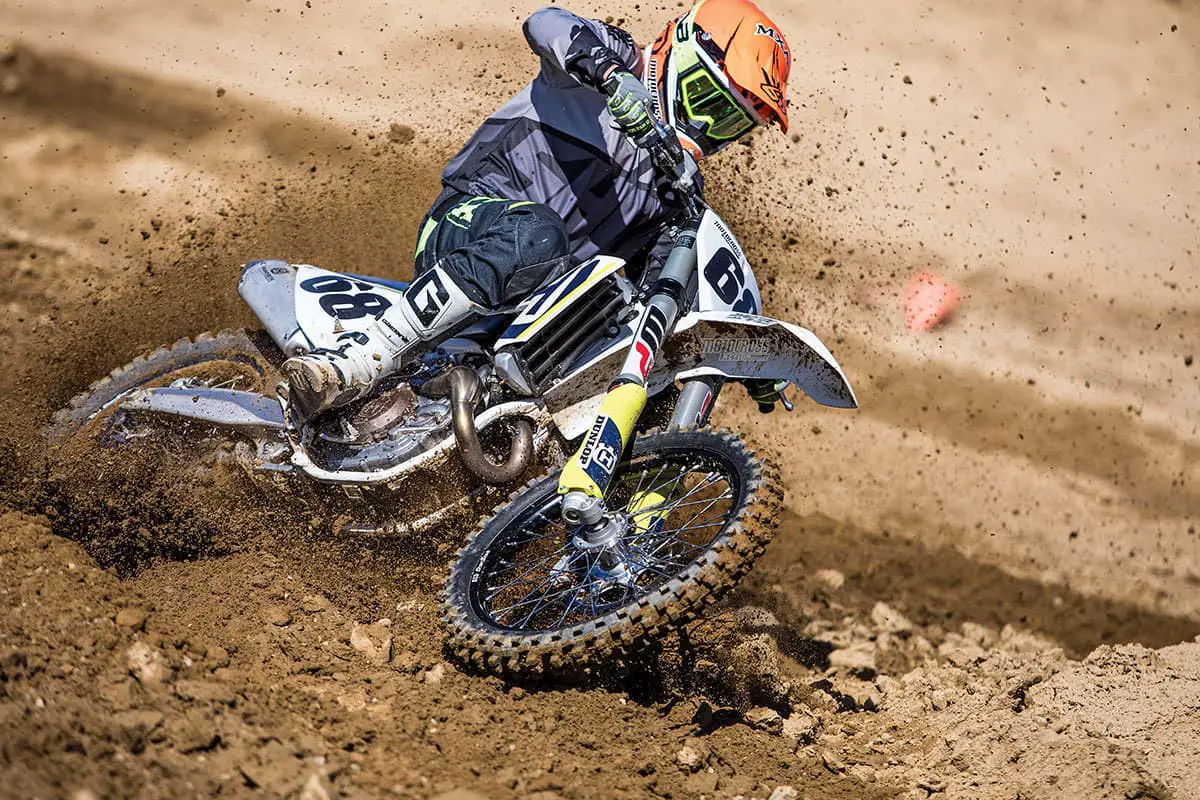 All you need to carve turns like this on a Husqvarna is Mr. Spock’s Mind Meld—think it and the FC450 does it.
All you need to carve turns like this on a Husqvarna is Mr. Spock’s Mind Meld—think it and the FC450 does it.
Need-to-do list. The 2018 WP AER forks have been updated with a new air seal, air piston and rebound spring on the air leg, along with a new piston on the damping side for improved performance. For 2018, the compression damping has been firmed up into the mid-stroke. Last year’s AER fork had free-bleed around the compression shim stack, which made the damping too light in the mid-stroke. The 2017 forks would suffer a high-speed flutter in consecutive braking bumps. For 2018, Husqvarna addressed this issue; however, what they did to the 2018 forks was not rocket science, and any reputable suspension tuner can duplicate the mods.
 Under the skin, the mechanical differences between a Husky FC450 and KTM 450SXF are the brake rotors, Magura clutch, D.I.D rims, muffler core and airbox.
Under the skin, the mechanical differences between a Husky FC450 and KTM 450SXF are the brake rotors, Magura clutch, D.I.D rims, muffler core and airbox.
Q: WHAT MODS DID HUSKY MAKE TO THE AER FORK INTERNALS FOR 2018?
A: Here is a quick list of what was changed on the WP AER air forks for 2018.
(1) Damping. The compression damping has been firmed up into the middle. Last year’s free bleed around the compression shim stack was the source of the flutter. For 2018, KTM has put a larger shim (30mm instead of 26mm) against the mid-speed valve to increase low-speed compression by 5 percent and to lessen the high-speed compression by 10 percent. The rebound-damping shim stack remains the same.
(2) Mid-valve. Last year’s mid-valve was constructed from a special ceramic composite material. Not only was it lighter than the previous steel mid-valve, it had wear qualities that were supposed to make it a big plus. Unfortunately, it wasn’t a plus. The composite mid-valve had some reliability issues, and for 2018 Husqvarna has returned to the previous sintered-steel mid-valve.
(3) Air seal. From the earliest prototype versions of the WP air fork, the air seal has undergone constant updates. The original 2016 seal could not handle cold temperatures and would leak air pressure from one chamber to the other. WP changed the seal material to a more resilient and less temperature-sensitive compound. Unfortunately, that was not the perfect cure. In 2017, when the AER forks were first introduced in the American market, the lip seal was replaced with a quad-ring seal. The quad ring solved lots of problems, but because it had four small sealing surfaces instead of one large one, repetitive wear became an issue. For 2018, the WP AER forks have switched to a larger rhomboid-shaped air seal to replace 2017’s quad-ring seal. The new seal has a unique, slightly out-of-square shape that increases surface area for better sealing and longer wear.
Q: WHAT ABOUT THE SWITCH TO MAGURA BRAKES?
A: Husqvarna had every intention of switching from Brembo brakes to Magura brakes for 2018. It never happened. It would be easy to assume that, in the face of howls of protest, Husky’s management had second thoughts about taking the best brakes in the sport off of their bikes and installing Magura brakes instead. In the end, Husky’s management team sent out a press release that said, “Following a sudden change in supplier availability, Husqvarna Motorcycles announces that the 2018 TC125, TC250, FC250, FC350 and FC450 will be equipped with the Brembo braking system instead of the previously announced Magura system.” Well, to be accurate, it is reported that some bikes will come with Magura brakes, but the majority will still have Brembos. It is possible that the Magura brakes are superior to the Brembos, but we will have to wait to find out.
Why would Husqvarna want to switch to Magura? Three reasons: (1) It is in the best interest of KTM/Husqvarna to keep the supply lines open with multiple suppliers, not just for leverage against one company, but to hedge against “a sudden change in supplier availability.” This is not unusual, as Japanese manufacturers often spec Showa on one model and Kayaba on the other, or Bridgestones and Dunlops across the model line. (2) Husqvarna already uses a Magura hydraulic clutch system on its bikes, while KTM uses Brembos, thus Husky has an existing supplier chain and working relationship with Magura. (3) It is possible that the Magura components are cheaper than Brembo, a price break that Magura may be willing to give in order to secure a contract for 30,000 brake systems per year. This, however, is a savings that would not be reflected in the retail price at the consumer level.
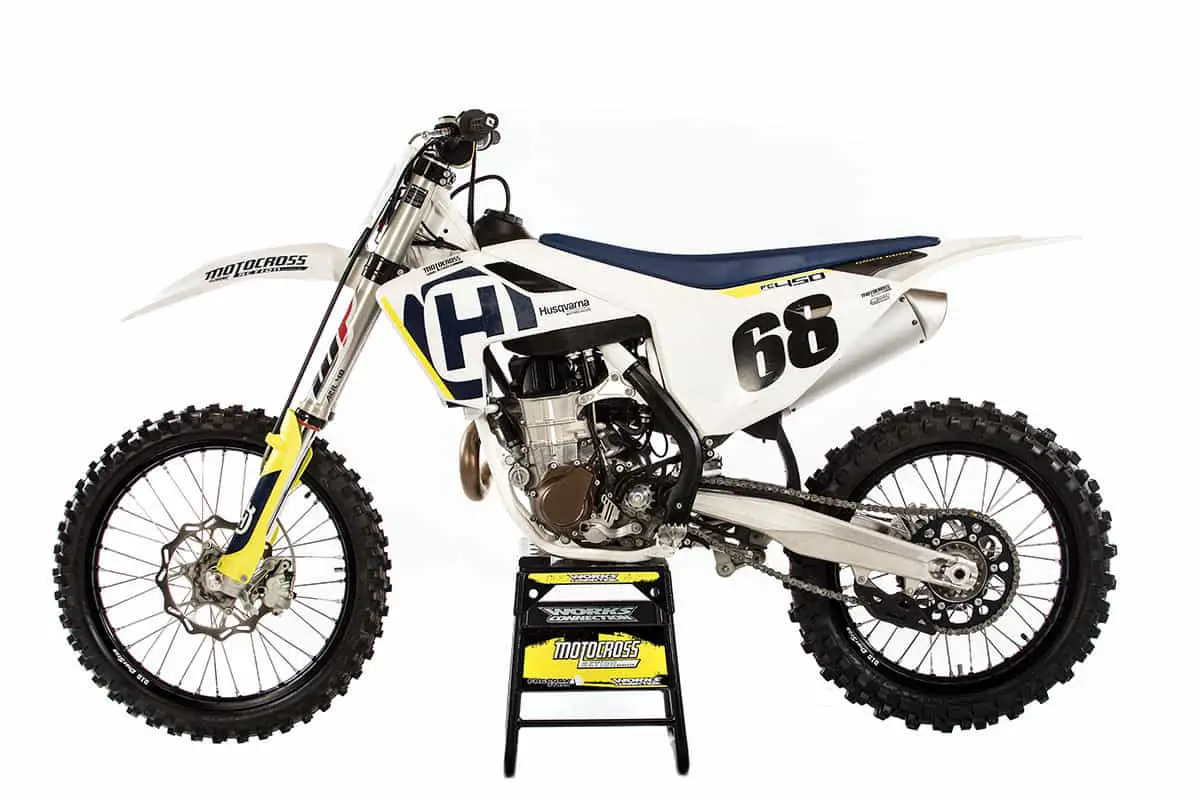 Husqvarna’s one-piece bodywork can be removed without any tools—well, the left side anyway. The right side has one pesky little bolt that spoils the fun.
Husqvarna’s one-piece bodywork can be removed without any tools—well, the left side anyway. The right side has one pesky little bolt that spoils the fun.
Q: WHAT’S THE DOUBLE-EDGED SWORD OF HUSQVARNA?
A: Platform sharing is a double-edged sword, whether between the Dodge ProMaster van and the Fiat Ducato van or with motocross bikes. First and foremost, Husqvarna is not fooling anyone. There is not a single buyer lined up to purchase a 2018 Husqvarna FC450 who doesn’t know that it is a clone of the 2018 KTM 450SXF. That is the burden of being white on the surface but orange underneath. Still, Husqvarna could not have found a better partner to dance with than the KTM 450SXF. Husky gets all that’s good about the MXA 450 shootout-winning KTM 450SXF.
The negative of platform-sharing is that the donor gets to do all the crowing, while the donee is a second cousin. On the other hand, Husqvarna didn’t have to start from scratch after leaving Italy. It got all of KTM’s engineering, computer power, dynos and technology for free—and a factory that produces almost 200,000 motorcycles a year at its beck and call. Thus, Husqvarna rode the coattails of KTM—and because they rode KTM’s coattails, they didn’t have to prove their worth. This kept the costs low and the consumers’ expectations high. In short, if you are going to beg, borrow or steal, you should always aim to co-opt a Ferrari 488 GTB instead of a Toyota Yaris, which is really a Mazda 2.
Q: HOW FAST IS THE 2018 HUSQVARNA FC450?
A: Not one iota faster than last year. Why not? Because the running gear remains essentially unchanged. Even though the FC450 is a clone of the 450SXF, it has a distinct personality that is unlike any other 450 on the track today. It is the perfect powerband for Justin Barcia’s smarter brother. While “Bam Bam” bounces his engine off the rev limiter and wheel-spins out of every corner, the Husqvarna FC450 has an educated and sophisticated powerband. The smartest way to race it is to carry speed, keep your momentum up and rely on late braking and smooth entrances. If you are a Bam Bam-style rider, don’t apply. This bike is built for technicians who use the metered power to cover ground fast, not spray ground into the air. Oh, don’t get us wrong; this is still a 58-horsepower machine that doesn’t have to bow down to anyone off the start or on fast straights; it’s just that it does it with less drama.
Compared to its closest relative, the KTM 450SXF, the FC450’s power delivery is easier to manage. That doesn’t mean that the 2018 Husky FC450 is slow; it’s just not a rompin’, stompin’ thrill ride. It is, for lack of a better phrase, a friendly 450. It has a metered pull, whereas the KTM 450SXF is snappier, more responsive and quicker from low to mid. The FC450 is the perfect bike for a rider who doesn’t want to play gun-and-run out of every turn. It gets the exact same job done with a steady, metronome powerband that ticks off faster and faster beats the longer you hold it on.
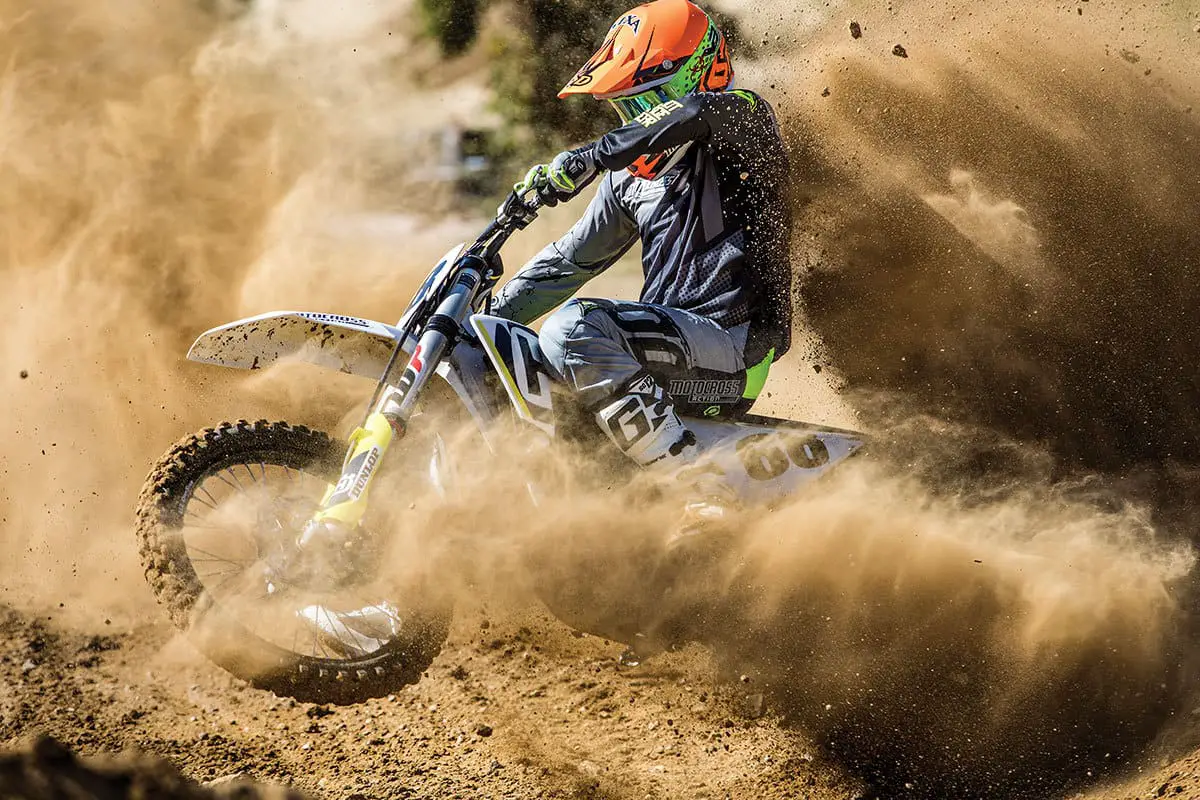 It should be noted that a “mellow” 450 is still a powerful machine that deserves respect.
It should be noted that a “mellow” 450 is still a powerful machine that deserves respect.
It’s a great bike for a faster rider with a flawless, calm, technical style, which means it is also an excellent Vet bike. It is best suited to two types of riders: (1) Riders who know how to carry speed, maintain momentum and select lines. (2) Riders who have been told that 450s are too powerful for mortal man. The FC450 will dispel that fallacy within a couple of laps.
Q: IF IT’S THE SAME ENGINE AS KTM’S, WHY IS IT DIFFERENT?
A: Husqvarnas come with a unique plastic airbox/subframe combo. From a feel standpoint, every MXA test rider likes the added resilience that the molded plastic airbox gives on jump landings and in heavy side-load. But, and this is the crux of the matter, the Husqvarna airbox does not breathe as well as the KTM’s more traditional airbox/subframe layout. The lack of air mellows out the FC450’s low-end throttle response—sometimes for the better and just as often for the worse.
 When you make a lot of horsepower, you can meter it out however you like. Husky went mellow, smooth and manageable.
When you make a lot of horsepower, you can meter it out however you like. Husky went mellow, smooth and manageable.
What’s better about it? The restrictive nature of the plastic airbox is what makes the power feel more cultured, manageable and easier to use.
What’s worse about it? Peak horsepower is measured when the engine is at full song—and when the Husqvarna FC450 is running wide open, it produces super-solid numbers. The problem isn’t at peak; the problem is below peak. Compared to the KTM 450SXF powerband, the Husky feels mellow. It is definitely slower on throttle response than its orange-tinted brother.
There are two diametrically opposed fixes for this battle between good and evil. First, you can let more air into the Husqvarna airbox by cutting away a section of the right side of the airbox (behind the side panel). This will allow more air in and perk up both the low-end power and the throttle response. Second, on the KTM you can place duct tape over the left-side air vent to give it the same pleasant powerband as the Husqvarna.
Q: HOW DOES THE 2018 HUSQVARNA FC450 HANDLE?
A: Until you spend time on a Husky FC450 on a technical motocross track, you will never appreciate how flawless it is. We love the way this bike handles. You think, “Go left.” It goes left. There is no oversteer. There is no understeer. There is no old-school hinge in the middle of the chassis. It’s supremely accurate and achieves this with minimal input from the rider. There is little doubt that the pleasant powerband and resilient subframe sharpen the rider’s senses and improve the frame’s response. MXA test riders, even those who prefer the KTM’s livelier powerband, like the Husky’s handling better than the KTM’s.
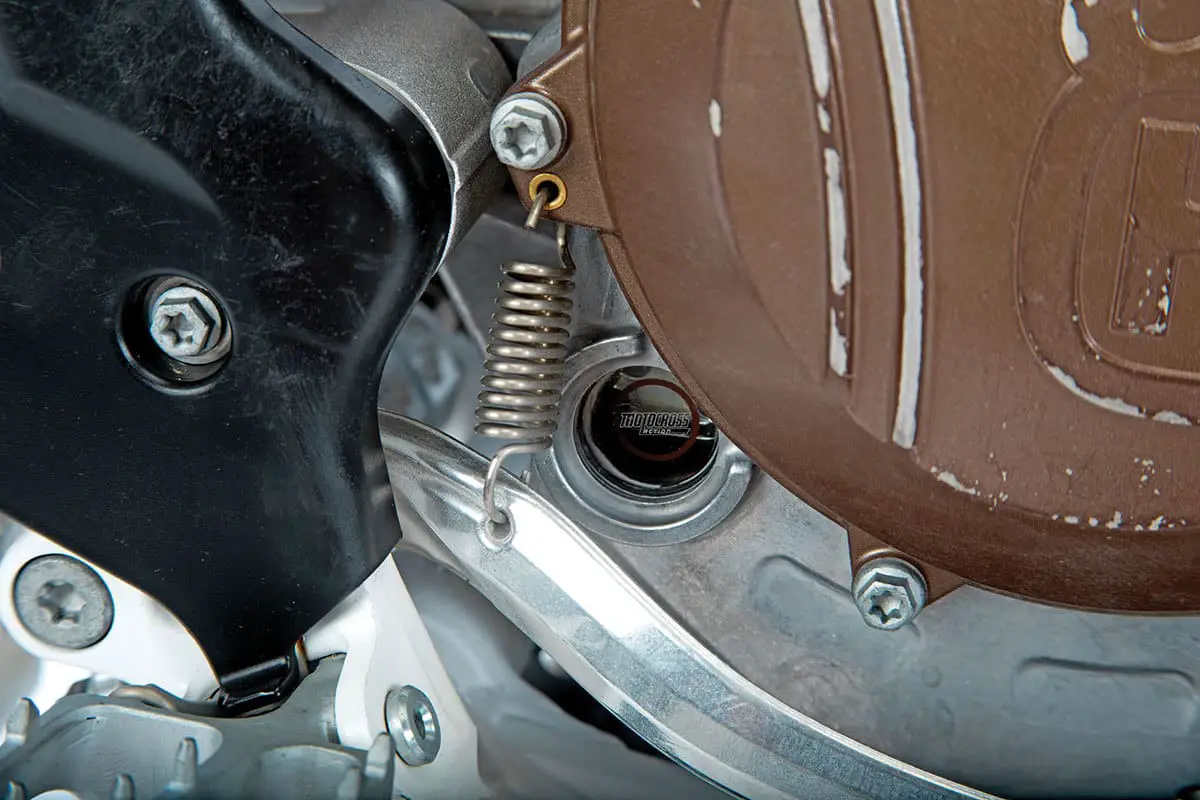 While this spring is flipped around in the correct direction, it will still break. How do we know? Believe us, we know.
While this spring is flipped around in the correct direction, it will still break. How do we know? Believe us, we know.
Q: HOW GOOD ARE THE 2018 WP AER FORKS?
A: Without a doubt, the WP AER air forks are the best air forks on the 2018 showroom floors. And, it won’t be long until they are the only air forks on the market—as the 2018 YZ450F, CRF450 and RM-Z450 are all coil-spring equipped. The manufacturers have dumped their Showa TAC and Kayaba PSF-2 air pumps in favor of coil springs, leaving only the KX450F hanging out to air-dry. Why did air forks suddenly fall out of favor? Blame it, or credit it, on a consumer revolt. Local racers could never come to terms with the complexity of dialing in three air chambers. The Showa and Kayaba air forks were too complicated. It was too hard to get them in the sweet spot and almost impossible to keep them there. Most riders stopped trying—and stopped buying.
So why have KTM and Husqvarna dropped their coil-spring forks in favor of air forks. Paradoxically, it was because they were late to the air-fork party. And this was a blessing. WP got to watch Showa and Kayaba air forks flounder, and thanks to a phenomenon called “the penalty of taking the lead,” WP was able to learn from the mistakes of its Japanese competitors and build a better mousetrap. Thus, WP AER air forks don’t have multiple air valves. They don’t require a degree in plasma physics to figure out. And, most of all, WP simply used the air pressure to replace the coil spring, not whistle Dixie and strum a guitar while hitting bumps. With AER forks, you simply find the best air pressure for your weight and speed and do all the rest of the tuning with the clickers. “Keep it simple, stupid” is why the WP air fork is here to stay, but instead of the WP AER air fork, it should have been called the WP KISS air fork.
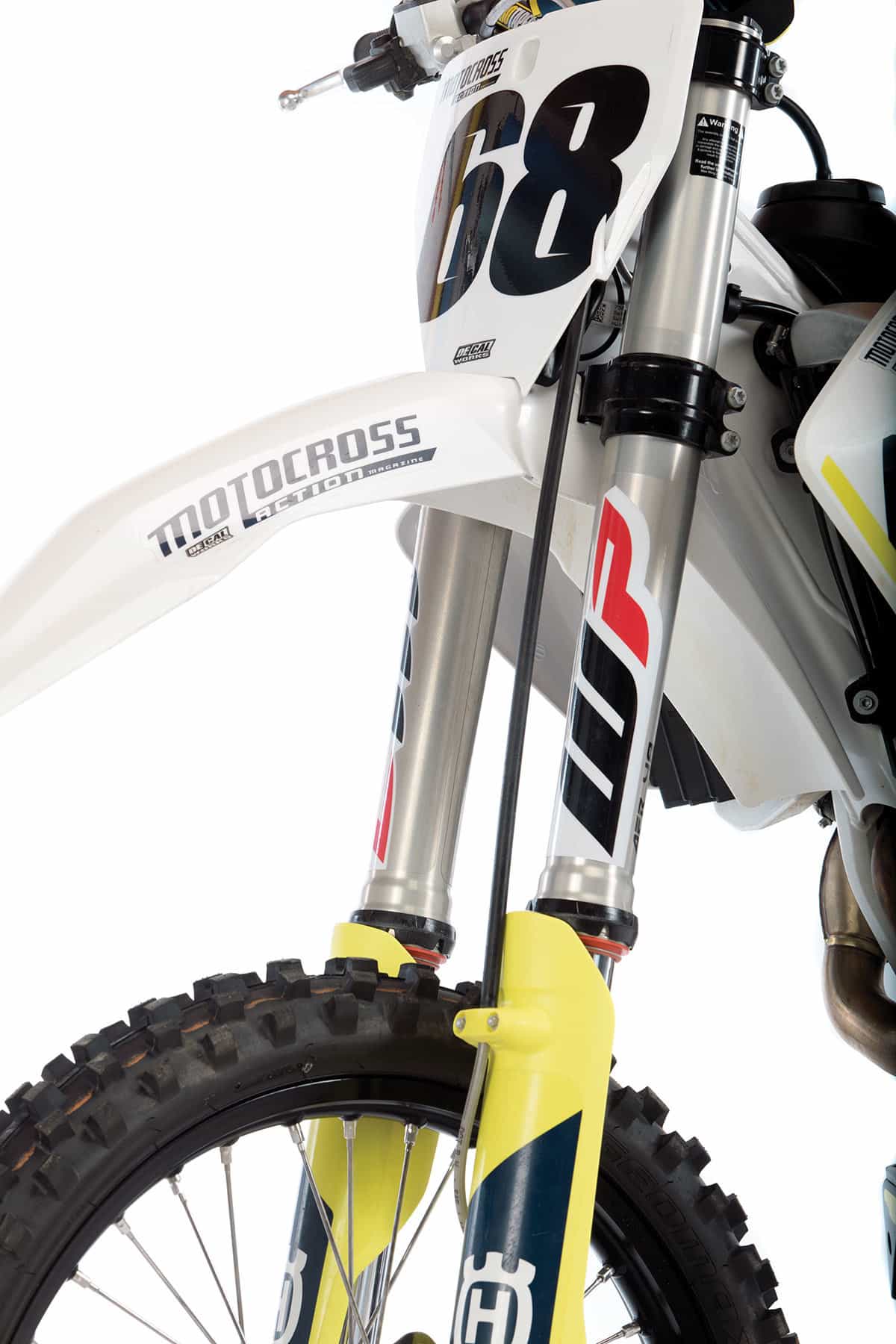 WP made improvements to the WP AER forks for 2018 that improve the feel in braking bumps and high-speed chatter.
WP made improvements to the WP AER forks for 2018 that improve the feel in braking bumps and high-speed chatter.
Every MXA test rider felt that the 2018 fork followed the ground better than last year’s fork. It didn’t flutter off little bumps and tracked across rough ground without lifting off. Sensitive test riders believed that the improved low-speed control helped the bike turn better‚ all this thanks to moving the 30mm shims up in the stack and the 26mm shims down. Overall, the 2018 WP AER air fork is an improvement over the 2017 AER fork.
Not to be forgotten is that air forks weigh 3 pounds less than coil-spring forks. This means that the 2018 Honda CRF450, with its coil springs and electric start, weighs 240 pounds. The Husky doesn’t have that weight penalty.
 No MXA test rider wanted Husky to switch from Brembo to Magura brakes. Thankfully, they didn’t.
No MXA test rider wanted Husky to switch from Brembo to Magura brakes. Thankfully, they didn’t.
Q: HOW MUCH DOES THE 2018 HUSQVARNA FC450 WEIGH?
A: On MXA’s scales, it came in at 224 pounds. That is 2 pounds heavier than the almost-identical KTM 450SXF, but 6 pounds lighter than a 2018 KX450F, 15 pounds lighter than a YZ450F and 16 pounds lighter than a Honda CRF450.
A: The hate list:
(1) Magura clutch slave seal. The seal in the Husky’s Magura slave unit will fail. If not today, then tomorrow. The quick fix is to order the Brembo slave unit’s piston and seal from the KTM clutch. It fits right in, and the Brembo’s seal does not fail.
(2) Spacers. There are spacers in the seat-bolt hole and right-side panel that fall out when you remove either of these two bolts. Shouldered bolts or tolerance-fit spacers would have solved this problem. We used grip glue.
(3) Exhaust. You can’t take the pipe off the bike without removing the shock. Once you change to an aftermarket pipe, this problem disappears. We have high hopes that Husky will fix this issue in 2019.
(4) Sprocket/spokes. Watch the sprocket bolts like a hawk. They loosen up constantly. The same holds true for the spokes. We added a tooth to the rear sprocket.
(5) Front brake hose. Be very careful when hooking tie-downs onto your handlebars that they don’t crimp the L-bend tube coming out of the front brake’s master cylinder. We would prefer more room between the brake line and the bars to lessen the chance of damage.
(6) Tiny Torx. Although the left-side panel pops off without any tools, the right-side panel requires a #20 Torx wrench or 6mm socket. Plus, you’ll need a #20 to bleed the forks. To make matters worse, the clutch-side ODI lock-on grip can only be removed with a #15 Torx wrench.
(7) Muffler core. Unlike the flow-through KTM muffler, the Husky FC450 muffler core has ice-cream-cone-shaped perf-core cones welded in to reduce sound and low-end power. This muffler was on KTMs five years ago, but KTM got rid of it because it hurt the bottom-end power. It still does.
(8) Gearing. You can drill the airbox and get rid of the ice cream cones to make the FC450 more responsive, but the best all-around fix is to gear it down one tooth.
(9) Frame guards. Why paint the frame white if you are going to cover the most visible parts with full-length black frame guards? News flash! White frame guards are available.
Q: WHAT DID WE LIKE?
A: The like list:
(1) Weight. The three-piece plastic airbox, ice-cream-cone perf core and heavier GFK brake rotors up the weight to 224 pounds. No sweat. That’s a lot less than the Kawasaki, Honda, Suzuki and Yamaha.
(2) Air filter. After years of having to wrestle big filters through small holes, the KTM/Husqvarna air-filter design is a blessing.
(3) AER forks. It’s nice to be able to say that the Husqvarna FC450 has the best air forks on the track (with the caveat that its cousin has the same forks).
(4) Powerband. If you want more horsepower, you can get it with a drill.
(5) Handling. You don’t have to point it where you want it to go; you just have to think it. The Suzuki may turn sharper, but it doesn’t have the balanced, do-it-all capabilities of the Husqvarna chassis.
(6) Hydraulic clutch. This Belleville washer-activated clutch is stout enough to last a full race season without being touched. But the slave unit seal isn’t.
(7) Cool stuff. Test riders were impressed by the light weight, hydraulic clutch, electric starting, awesome airbox, superb shifting, mud-free footpegs, in-mold graphics, tunable air forks and flawless handling.
(8) Heat shield. In 2017 the right-side panel melted. In response, Husqvarna welded a tab on the mid-pipe to hold a rubber bumper to keep the side panel from melting.
 If Husqvarna is going to mount giant black frame guards to cover up the white frame, then just paint the whole thing black.
If Husqvarna is going to mount giant black frame guards to cover up the white frame, then just paint the whole thing black.
Q: WHAT DO WE REALLY THINK?
A: If you’re inclined to think of Husqvarna as a boutique brand, a small private effort in the image of Husaberg, TM or SWM, think again. The vast majority of Husqvarna’s production is dedicated to dirt bikes, and its production numbers over the last four years make it the fastest-growing motorcycle brand—all the more impressive in a flat market (for anything that isn’t orange). In its first year under KTM’s mantel, Husky sold 16,337 bikes. In 2015 that number jumped to 21,513, and in 2016 sales topped out at 30,000 units. The 2017 numbers aren’t in yet, but Husqvarna is not small potatoes in the motorcycle world. And, unlike the “Big Four” Japanese brands, it makes 50cc, 65cc, 85cc and 125cc two-strokes; 250cc two-strokes; 250 four-strokes; and 350 and 450 motocross bikes (and has a fuel-injected 250cc two-stroke ). Husqvarna is the real deal. And for those who hark back to the Swedish days, it is three times bigger than Husqvarna AB ever was.
MXA’S 2018 HUSQVARNAFC450 SETUP SPECS
This is how we set up our 2018 Husqvarna FC450 for racing. We offer it as a guide to help you find your own sweet spot.
AER FORK SETTINGS
The majority of MXA test riders ignore the recommended numbers and run pressures as low as 130 psi. As a group, almost every test rider ran less than 156 psi in the FC450 forks. The best way to find the proper air pressure is to put a zip-tie on one fork leg and go out and ride. Keep changing the air pressure until the zip-tie is 1.5 inches from bottoming. That is your air pressure. From there on, use the compression clicker to control the travel. Don’t be afraid to use the clicker to its fullest. We have test riders who run 6 clicks out and test riders who run it 30 clicks out. For hardcore racing, we recommend this fork setup for an average rider on the 2018 Husqvarna FC450 (stock specs are in parentheses):
Spring rate: 140 psi (156 psi)
Compression: 18 clicks out (12 clicks out)
Rebound: 15 clicks out (12 clicks out)
Fork-leg height: Third line
Notes: Slower or lighter riders might have to lower the oil height in the damping leg by 10mm or more to get full travel. Additionally, pay attention to extreme temperature changes. You may have to change the AER’s air pressure as it gets hotter later in the day. We bleed the outer chambers constantly.
WP SHOCK SETTINGS
The 2017–2018 Husqvarna FC450 comes with a 45 N/m shock spring. This is an excellent choice for the size and weight of most riders; however, if you are heavier than 180 pounds, you might want to run the 2016’s 48 N/m spring. This is a very good production shock. It can be dialed in with only a few clicker changes. As a rule of thumb, most MXA test riders leave the low-speed compression on the stock setting and focus on the high-speed dial to make the changes. We do run additional rebound damping. For hardcore racing, we recommend this shock setup for the 2018 Husqvarna FC450 (stock specs are in parentheses):
Spring rate: 45 N/m
Race sag: 105mm (110mm)
Hi-compression: 1-3/4 turns out (2 turns out)
Lo-compression: 15 clicks out
Rebound: 10 clicks out (15 clicks out)
Notes: We turned the high-speed compression damping in a quarter turn to lessen G-outs and run more rebound than the recommended setting. Additionally, we set the sag at 105mm instead of the WP-recommended 110mm.
 Had you subscribed to MXA, you would have read this complete bike test when in came out back in October. Click the box below to subscribe.
Had you subscribed to MXA, you would have read this complete bike test when in came out back in October. Click the box below to subscribe.


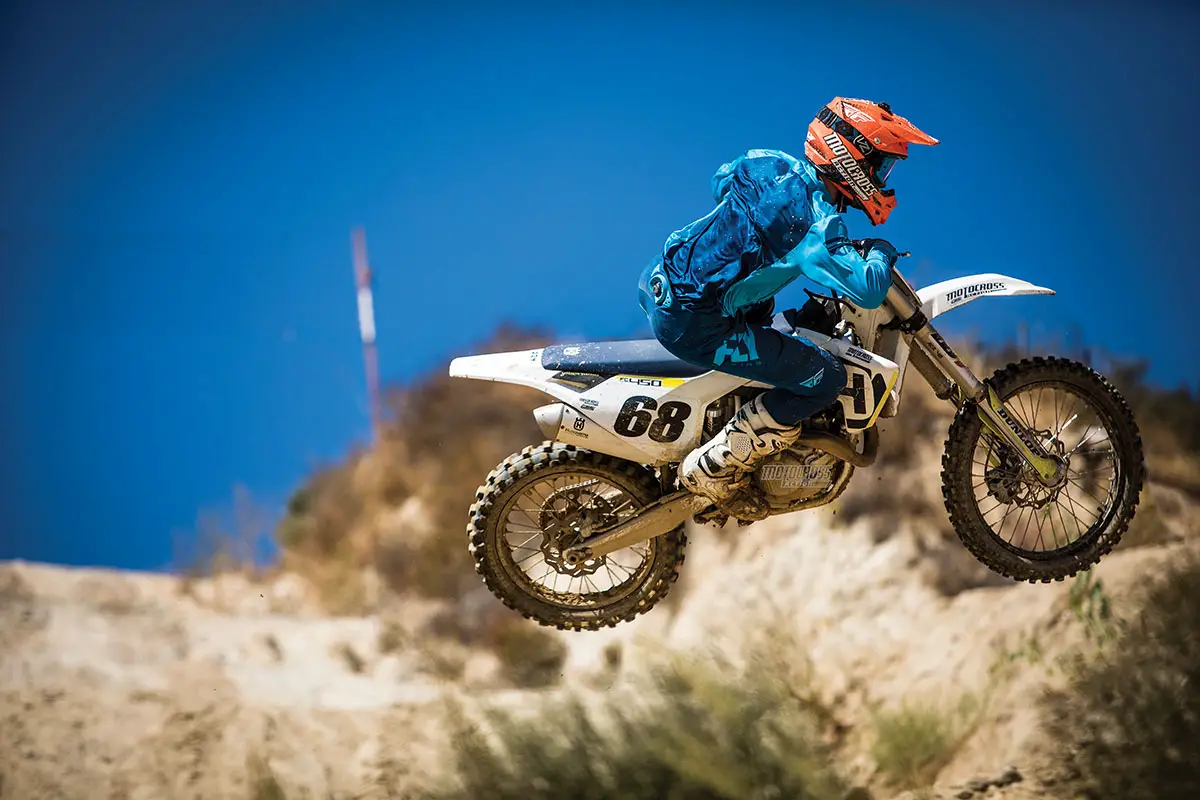
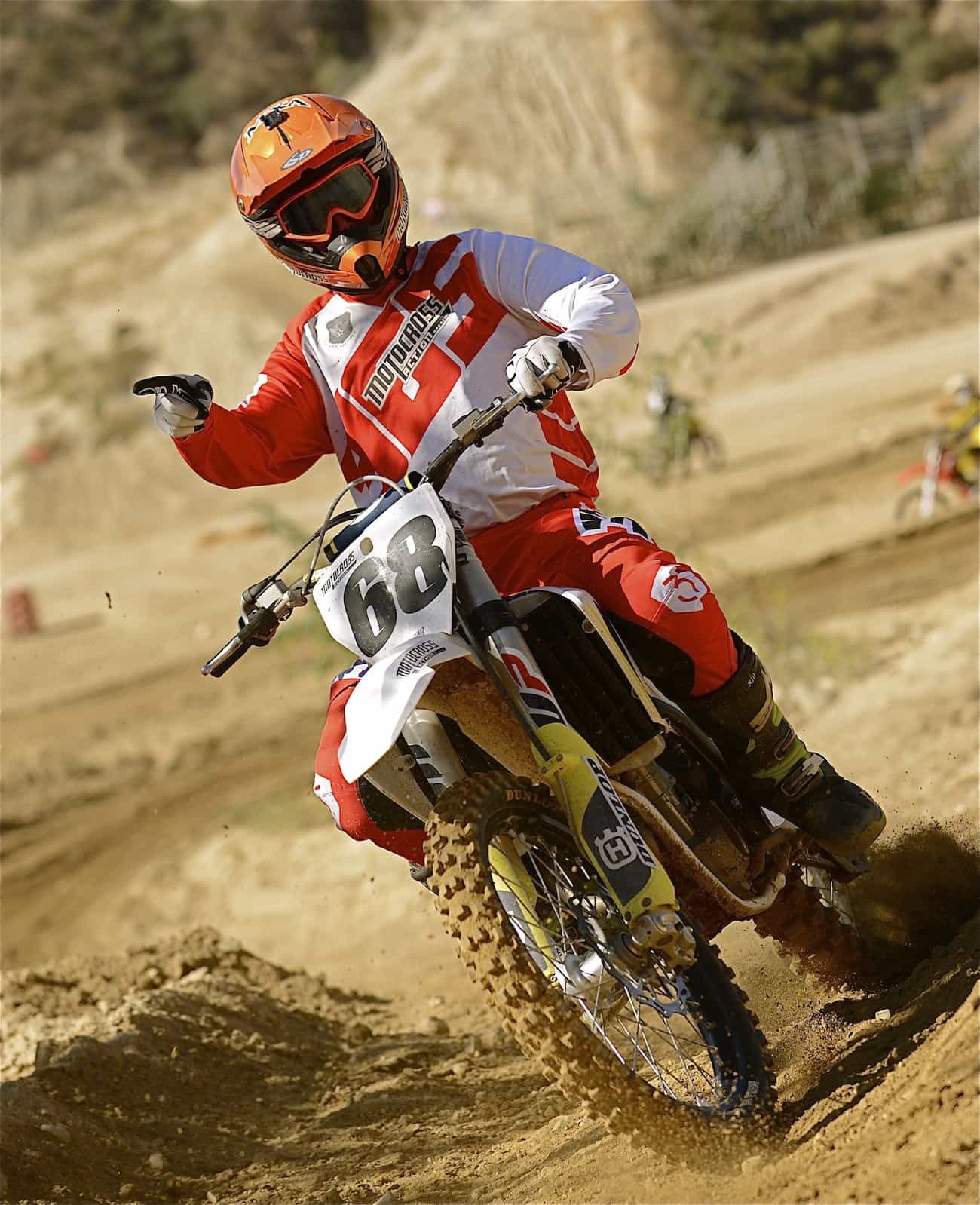






Comments are closed.